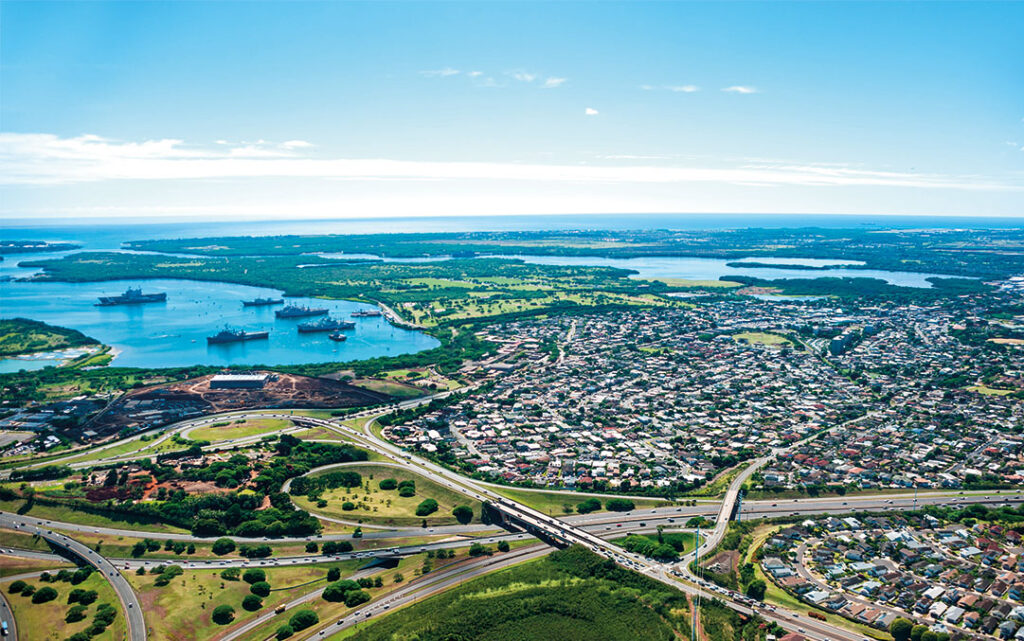For centuries, Hawai‘i’s location in the heart of the Pacific has made it a critical hub for global trade, cultural exchange, and national defense. Today, Hawai‘i remains one of the most strategically significant military locations in the world, hosting key commands from all branches of the U.S. military and serving as the forward edge of defense operations in the Indo-Pacific region.
With growing geopolitical tensions, evolving security threats, and the increasing importance of a free and open Pacific, the U.S. military presence in Hawai‘i is essential to maintaining regional stability, protecting national interests, and ensuring the safety of allies and partners.
Why Hawai‘i is Vital to U.S. and Global Security
U.S. Indo-Pacific Command (USINDOPACOM), the oldest and largest U.S. combatant command, is headquartered at Camp Smith in Hālawa on O`ahu and is the senior U.S. military commander for the Pacific and Indian Ocean areas. It is a joint command comprised of forces from USARPAC, MARFORPAC, PACFLT, PACAF, USSPACEFORINDOPACOM and in times of conflict, the U.S. Coast Guard, part of the Department of Homeland Security. Special Operations Command (SOCPAC), US Forces Korea (USFK) and US Forces Japan (USFJ) also report to USINDOPACOM.
- USARPAC stands for U.S. Army Pacific – oversees Army operations in the region, including Hawai`i, Alaska, Japan, and South Korea.
- MARFORPAC stands for U.S. Marine Forces Pacific – Oversees Marine Corps forces from the waters off the west coats of the United States to the western border of India, and from Antarctica to the North Pole.
- PACFLT stands for U.S. Pacific Fleet (Navy) – commands naval forces in the Pacific, covering nearly half the Earth’s surface, encompassing approximately 100 million square miles.
- PACAF stands for U.S. Pacific Air Forces – manages Air Force missions throughout the Indo-Pacific in 38 nations spread across 52 percent of the Earth’s surface and 16 time zones.
- USSPACEFORINDOPACOM stands for U.S. Space Forces Indo-Pacific – coordinates space-related missions and support in the Indo-Pacific region
Hawai‘i’s strategic location enables rapid deployment, intelligence gathering, and coordination with allies across the Pacific, helping deter potential conflicts and ensuring global stability. Key advantages include:
- Strengthening Regional Stability & Defense Readiness. With its proximity to the Asia-Pacific region, Hawai‘i is at the forefront of deterring aggression and supporting a rules-based international order. The military’s presence in Hawai‘i enables:
- Quick response capabilities to emerging threats in the Pacific.
- Joint training exercises with allied forces, strengthening military cooperation with nations like Japan, Australia, and the Philippines.
- Strategic deterrence through military preparedness, ensuring potential adversaries think twice before challenging regional security.
- Safeguarding Indo-Pacific Trade & Supply Chains. The Pacific is home to some of the world’s busiest shipping routes, responsible for the movement of trillions of dollars in goods and resources annually. A stable, secure Pacific ensures:
- Uninterrupted global trade for U.S. and international markets.
- Protection of undersea cables, which carry critical communications data.
- Defense against piracy, cyber threats, and unlawful territorial claims.
- Enhancing Innovation & Military Readiness. Hawai‘i serves as a testing ground for cutting-edge military technologies, including:
- Cybersecurity training and space operations at Joint Base Pearl Harbor-Hickam.
- Autonomous systems and artificial intelligence research for naval and air operations.
- Advanced and additive manufacturing initiatives focusing on enhancing operational capabilities and logistical efficiency.
- Disaster Response & Humanitarian Assistance. Beyond defense, Hawai‘i’s military forces are critical first responders for natural disasters and humanitarian crises across the Pacific. From tsunamis and hurricanes to earthquakes and wildfires, military personnel provide:
- Search and rescue operations for affected populations.
- Disaster relief and supply distribution to remote island communities.
- Medical assistance and field hospital support in crisis zones.
- Strengthening Alliances & International Partnerships. Hawai‘i serves as a key diplomatic and operational hub for U.S. alliances and partnerships in the Indo-Pacific. The U.S. military regularly conducts joint training exercises, security dialogues, and humanitarian missions with regional partners, including:
- Japan, South Korea, and Australia – Key defense allies collaborating on security initiatives.
- Philippines and Thailand – Treaty allies participating in military training and counterterrorism efforts.
- Pacific Island nations – Receiving disaster relief, security assistance, and infrastructure support.
Lastly, the military isn’t just in Hawai‘i to project power abroad. It plays a frontline role in keeping Hawai‘i itself safe through deterrence, detection, defense systems, and rapid response forces.
As geopolitical challenges evolve, Hawai‘i’s military presence will continue to play a crucial role in defending the Pacific. The region’s importance to national security, economic stability, and international diplomacy will only grow in the years ahead. By investing in military readiness, strengthening partnerships, and leveraging cutting-edge technology, Hawai‘i remains a cornerstone of U.S. and allied defense strategy—ensuring a secure, stable, and prosperous Pacific for generations to come.

